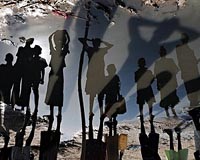| . |  |
. |
Dehradun, India (AFP) Jan 12, 2010 Hundreds of ash-covered, naked holy men and millions of Hindu pilgrims are making their way to northern India to take part in one of the largest religious gatherings on Earth. For Hindu devotees, the three-month Kumbh Mela, which begins Thursday in the towns of Haridwar and Rishikesh, offers the chance to wash away their sins with a ritual bath in the holy waters of the River Ganges. Even in a country where mass events are commonplace, the Kumbh Mela stands apart for its sheer size and the enormous logistical task involved in its organisation. "Putting on the Kumbh Mela is like setting up a city within a city," said Alok Sharma, the director general of the 2010 event. An area of 130 square kilometres (50 square miles) has been set aside to host the five million pilgrims expected to participate in the first of four auspicious bathing dates on January 14. Millions more will pass through the site as the festival unfolds, with the largest gathering of all expected on the final and most auspicious bathing day of all on April 14 which is led by the naked Naga sadhus (saints). The Mela marks the only public gathering of the Nagas, many of whom live in remote, spartan conditions in mountains, caves and communes in the Himalayas and other regions of India. The highest ranked among them will ride in chariots decorated with marigolds and pulled by tractors, while others follow behind, carrying swords, tridents and saffron flags. Naked and generally covered in a layer of grey ash, they are regarded by devotees as earthly representatives of the gods because of their self-sacrifice and denial of the material world. Their isolation does not, however, prevent their organising for particular causes and they plan to use the 2010 Kumbh Mela to highlight the issue of global warming. "Sadhus like us who go up to the higher reaches of the Himalayas to meditate have a clear picture of how bad the situation is," Soham Baba, considered as the head of the Nagas, told reporters recently in Kolkata. "Pristine lakes and waterfalls that existed till a few years ago have dried up," he said. "The Kumbh Mela will be the appropriate place to protest," he added. The mass of humanity poses enormous challenges, not least of all from a security angle. Sharma said police and paramilitary forces have been deployed around the bathing ghats and bomb disposal units will be on standby for the duration. "Every inch of Haridwar will be closely monitored on close-circuit televisions," he added. Special tented areas will be reserved for men and women and 40 first aid units will attend to the injuries that inevitably occur as the millions of pilgrims congregate at the bathing ghats. The festival commemorates a mythical battle between gods and demons over a pitcher of the nectar of immortality. During the struggle, a few drops of nectar fell in four different places: Allahabad, in the state of Uttar Pradesh, Haridwar in Uttarakhand, Ujjain in Madhya Pradesh and Nasik in Maharashtra. The Kumbh Mela alternates between these four places and takes place every three years. Once every 12 years, an even larger Maha Kumbh Mela is held. The next will be in Allahabad in 2013. As well as cleansing them of their sins, pilgrims believe bathing in the Ganges during the festival will help liberate them from the cycle of birth and reincarnation.
Share This Article With Planet Earth
Related Links Water News - Science, Technology and Politics
 Water Cycle Conference Makes A Big Splash
Water Cycle Conference Makes A Big SplashParis, France (ESA) Jan 07, 2010 Earth has a limited amount of water that recycles itself in what is called the 'water cycle'. Climate change, weather and human life are highly affected by changes in this continuous, interconnected cycle. Observing and monitoring the key variables governing the global water cycle is essential to our understanding of the Earth's climate, forecasting our weather, predicting floods and droug ... read more |
|
| The content herein, unless otherwise known to be public domain, are Copyright 1995-2009 - SpaceDaily. AFP and UPI Wire Stories are copyright Agence France-Presse and United Press International. ESA Portal Reports are copyright European Space Agency. All NASA sourced material is public domain. Additional copyrights may apply in whole or part to other bona fide parties. Advertising does not imply endorsement,agreement or approval of any opinions, statements or information provided by SpaceDaily on any Web page published or hosted by SpaceDaily. Privacy Statement |